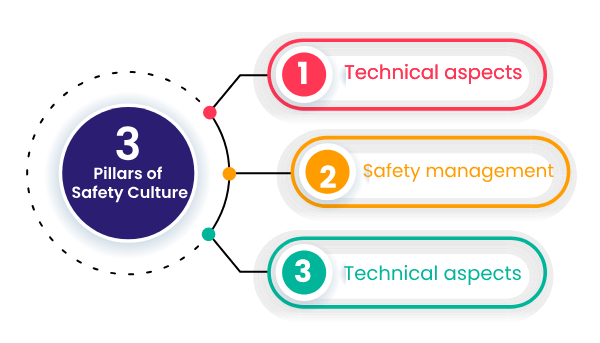What is safety culture?
Safety culture refers to the shared values, attitudes, beliefs, and behaviors within an organization regarding safety. It represents the collective way in which individuals at all levels of an organization prioritize and approach safety in their day-to-day activities.
A positive safety culture is characterized by a strong commitment to safety, open communication about safety concerns, and a proactive approach to identifying and addressing potential risks.
Three Pillars of Safety Culture
Improving the safety culture requires an integrated approach to safety through coherent actions in three areas:

Key elements of a safety culture include
- Leadership Commitment: Leaders’ commitment to safety is crucial. When leaders prioritize and actively support safety initiatives, it sets the tone for the entire organization.
- Communication: Clear and open communication about safety policies, procedures, and expectations is essential. It facilitates the exchange of information about potential hazards and safety protocols.
- Employee Involvement: In a positive safety culture, employees actively participate in safety processes, reporting hazards, joining safety training, and contributing ideas for improving safety practices.
- Continuous Learning: A safety culture promotes continuous learning and improvement. Organizations valuing safety commit to identifying lessons from incidents, near misses, and audits to enhance safety measures.


- Accountability: Individuals are accountable for their safety performance, which involves following safety procedures, using personal protective equipment (PPE), and actively contributing to maintaining a safe work environment.
- Recognition and Positive Reinforcement: Positive reinforcement for safe behaviors and achievements is essential in a positive safety culture. Recognizing and rewarding individuals or teams for their commitment to safety fosters a culture of appreciation.
- Non-Punitive Reporting: Encouraging a non-punitive approach to reporting safety concerns ensures employees feel comfortable reporting hazards and incidents without fear of reprisal, promoting transparency and proactive risk management.
- Integration with Operations: Safety is woven into all aspects of organizational operations, not treated as a separate entity but considered an integral part of decision-making and daily activities.
- Shared Responsibility: Safety is viewed as a shared responsibility among all members of the organization. Every individual, from top management to frontline employees, plays a role in creating and maintaining a safe work environment.
- Adaptability: A positive safety culture adapts to change, embracing new information, technologies, and best practices that contribute to improved safety outcomes.
- Safety Committees: Creating safety committees or teams enables collaborative efforts to promote safety, share information, and address safety-related concerns.

Key elements of a safety culture include
Building a safety culture at work is vital for a healthy and productive environment, and employees are pivotal in fostering this culture. Here are tips for employees to
- Know and Follow Procedures: Know and get acquainted with safety procedures and guidelines related to your job. Always adhere to established protocols when handling equipment, machinery, or hazardous materials.
- Report Hazards and Incidents: Report safety hazards, potential risks, or incidents promptly to your supervisor or the right personnel. Give detailed information about the nature of the hazard or incident to help with proper resolution.
- Use Personal Protective Equipment (PPE): Use the necessary PPE for your job, like helmets, gloves, goggles, or other safety gear. Check that your PPE is in good condition and report any issues with its functionality.
- Practice Good Housekeeping: Maintain clean and organized work areas to prevent slips, trips, and falls. Store tools and equipment properly after use to avoid potential hazards.
- Take Breaks and Manage Fatigue: Take breaks regularly to prevent fatigue and reduce the risk of accidents. Avoid working too many hours, and let supervisors know if you feel tired or unwell.
- Participate in Safety Training: Participate in your employer’s safety training sessions and stay informed about safety protocols, emergency procedures, and any updates to workplace safety policies.
- Encourage Open Communication: Encourage open communication for employees to discuss safety concerns without fear of reprisal. Join safety meetings and discussions to share insights and experiences.
- Promote Ergonomics: e mindful of your posture and workspace ergonomics to avoid musculoskeletal issues. If you experience discomfort or pain, report it early to address ergonomic concerns promptly.
- Be Mindful of Mental Health: Understand that mental health is crucial for overall well-being. If you feel overwhelmed or stressed, don’t hesitate to speak up and seek support from supervisors or employee assistance programs.
- Emergency Preparedness: Be aware of where emergency exits, first aid kits, and fire extinguishers are located. Learn and take part in emergency evacuation procedures and drills.
- Encourage Co-worker Safety: Watch out for your colleagues and promote safe practices. If you see unsafe behavior, address it politely or report it to the right channels.
- Continuous Improvement: Offer ideas to improve safety protocols from your experiences. Keep a mindset of consistently making safety practices better. Actively joining in to build a safety culture helps employees create a workplace that values well-being and lowers the risk of accidents and injuries.
‘Creating a safety culture motivates employees to actively contribute to a secure work environment by following protocols and promoting open communication.’
Contact Us
Kindly call our Experts @ +91 8121563728 / +91 8015527650 or mail us @ kalyan.r@greenworldsafety.com / indumanasa.m@greenwgroup.com
Get Your Query Answered / Get Expert Assistance To Choose the Right Course for You Or Your Associates






